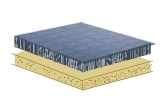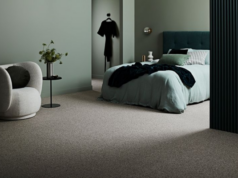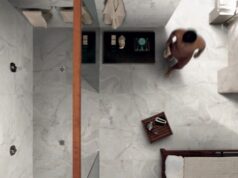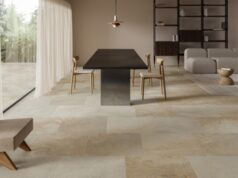
Carpet can add colour and warmth to your home, as well as a comfortable, forgiving surface on which to walk.
What are carpets made of?
Carpet has long been a popular choice as a floor covering due to the comfort and warmth it provides, and to the versatility of styles available. Carpet is normally made either from one, or a blend of three main fibres; wool, nylon and polypropylene.
- Wool – These carpets tend to be more expensive, but are valued for their luxurious feel, insulative properties, lasting durability and natural resistance to stains. Wool is commonly blended with a synthetic fibre like nylon or polypropylene (typically about 80% wool, 20% synthetic – or ’80/20′) to make it more durable and resistant to wear. Wool blends are often used for cut plush pile and twist pile carpets.
- Nylon – Probably the most commonly used carpet material, nylon can be used to make just about any style or colour of carpet. Nylon is strong, and as a result nylon carpets tend to be very resilient. Unless they’re specifically treated for stain resistance during manufacturing, nylon carpets are also prone to staining.
- Polypropylene – Similar to nylon in many respects, polypropylene is considered a ‘cost-effective’ carpeting option. Polypropylene is not as durable or hard-wearing as wool or nylon, and is more difficult to dye. Polypropylene is well suited to certain types of carpet (including short-looped Berber carpets), and retains its looks well when used properly. Polypropylene is commonly used in offices and commercial environments.

How are carpets made?
The most common way of producing carpet is by tufting. The carpet yarn is threaded through hundreds of needles on a machine, and these are pushed through a primary backing sheet. The yarn is either left looped or is cut, depending on the style. The length of the loops determines the pile length. The underside of the backing sheet is then coated with synthetic latex, and a second backing sheet is pressed on for stability. Other methods include woven and modular carpets.
What is underlay?
Underlay is what the carpet sits on to give it bounce and form. Underlay is typically made of foam, rubber or felt. It helps improve acoustic dampening as well as adding to the carpet’s thermal insulation, and also reduces stress on the carpet, increasing its lifespan. The importance of good underlay cannot be overlooked, as it will directly contribute to the life and performance of the carpet.
What to look for in a carpet and underlay
Carpet varieties are nearly endless in colour, pattern and weave combinations. The length of pile and looped or cut-looped variations can be blended to create thousands of different styles and effects. Depending on the rooms, décor and your budget, you will be able to find a carpet to match just about any area in the house.
You should think about the amount of foot traffic the area is likely to receive, as well as where heavy furniture is likely to be sitting for long periods of time. Areas with a lot of expected wear and tear such as main hallways should be covered with a more hard wearing yarn.
Many carpets are rated for performance by the Australian Carpet Classification Scheme (ACCS). The rating is normally featured on a blue and yellow ‘Residential Guide’ label, and signifies the carpet’s expected durability and appearance retention. The more stars it has (up to a maximum of six for residential carpeting) the better longevity you can expect.
How is carpet installed?
First, the area to be covered is measured up and planned by your retailer, and the subfloor is cleaned. Next, tackless strips are placed along each wall and the underlay is rolled out and cut to size, leaving the strips exposed. Then, lengths of carpet are laid perpendicular to the underlay, stretched over the tackless strips and trimmed flush with the wall.
Suitability and maintenance
Carpet will suit almost any room in your house, except for wet areas like the bathroom and laundry. It is warm, relatively easy to maintain and feels comfortable to walk on.
Looking after carpet is easy: simply vacuum regularly to get rid of dust and dirt, and avoid spills. When a carpet gets dirty and you walk on it, the dirt will wear against the carpet fibres, so keeping it clean is a big factor in how long it will last. Check with your installer too – in most cases, the carpet’s warranty will require that you have it professionally steam- or dry-cleaned once every six to twelve months.
It’s a good idea to move furniture around semi-frequently, especially on longer pile carpets. This will help prevent compressed areas and discolouration due to irregular light exposure. Put plastic capping under any heavy furniture, such as the feet of the couch. Staining can be a problem, especially for lighter coloured carpets. Stain removers can be used, though steam cleaning may be required.
|
Advantages
|
Disadvantages
|





